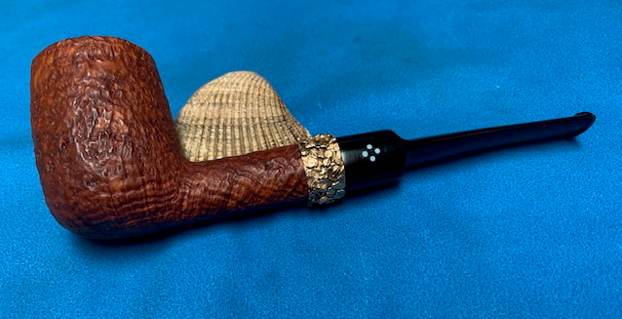Blog by Steve Laug
The next pipe I have chosen to work on is a nice looking sandblast straight billiard with a sandblast rim top and a gold band on the shank. The stem is an original saddle stem. We picked it up on 11/18/2021 from a fellow in Gardenia, California, USA. The stamping on the underside of the shank reads “Buckingham” S on the heel of the bowl followed by three lines reading Sasieni [over] Four Dot [over] “Ruff Root”. Next to that stamping there is a single line reading London Made with the chunky gold band covering a portion of the stamping. The vulcanite saddle stem has the four light blue dots on the left side of the saddle. The pipe is a nice looking pipe with a reddish brown finish that highlights the sandblast on the bowl sides and shank. The bottom of the shank and bowl are flattened so that the pipe sits on the desktop. There is a sandpit on the right side of the bowl mid bowl. On the underside there is a putty fill running diagonal across the heel. The vulcanite stem is set apart from the shank by the gold nugget band. It is light weight and comfortable pipe to hold. Jeff sent me the following photos of the pipe to show the condition it was in before he worked on it.
This is what I saw when I looked over the pipe.
- The finish shows darkening of hand oils and some thick grime ground into the sand blast finish around the bowl sides. The stain is dull and the grain patterns under the grime are obscured around the bowl sides and shank
- The sandblast rim top was very dirty with darkening and lava ground into the blast. It is heavier on the back side. The inner edge of the bowl looks quite good under the tars.
- There was a thick cake in the bowl. The bowl itself was very dark and dirty. Once the bowl was cleaned up we could confirm the condition of the bowl walls.
- The vulcanite stem was filthy, oxidized and had tooth marks and chatter on both sides. There were some deeper tooth marks on the underside ahead of the button.
- There is a standard pattern Sasieni Four Dot logo on the stem that appears to be light blue in colour.
To summarize what I saw – this Sasieni Four Dot Ruff Root Sandblast Billiard is a well made pipe. The bowl and stem are very dirty which says to me that the pipe was someone’s favourite pipe. The look and feel of the pipe in the hand is great. It should clean up very well. Here are photos of the pipe taken before Jeff started the clean up. 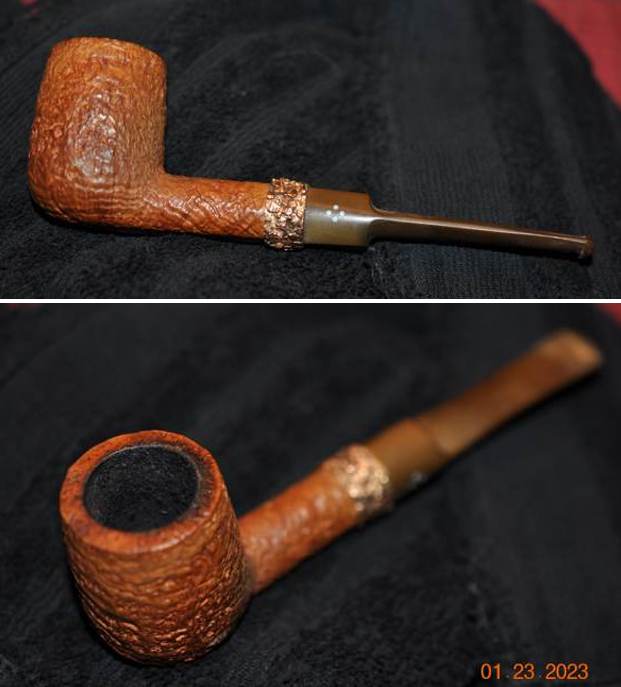 Jeff took close up photos so that I could have a clearer picture of the condition of the bowl, rim edges and top. The rim top photos confirm my assessment above. The cake in the bowl is thick – covering the walls of the bowl. The rim top has thick lava coat and has some darkening on the inner edge and is heavier toward the back of the bowl. This is what I look for when assessing a pipe. I look forward to viewing it in person after the clean up work.
Jeff took close up photos so that I could have a clearer picture of the condition of the bowl, rim edges and top. The rim top photos confirm my assessment above. The cake in the bowl is thick – covering the walls of the bowl. The rim top has thick lava coat and has some darkening on the inner edge and is heavier toward the back of the bowl. This is what I look for when assessing a pipe. I look forward to viewing it in person after the clean up work. 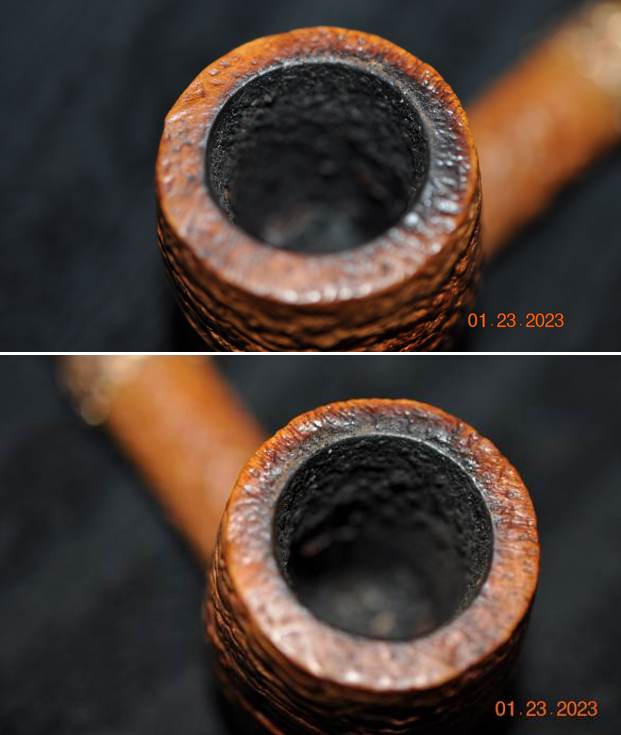 The stem is dirty, oxidized, calcified and has grime all over the surface as noted in the description above. There are toothmarks and chatter on both sides ahead of the button.
The stem is dirty, oxidized, calcified and has grime all over the surface as noted in the description above. There are toothmarks and chatter on both sides ahead of the button.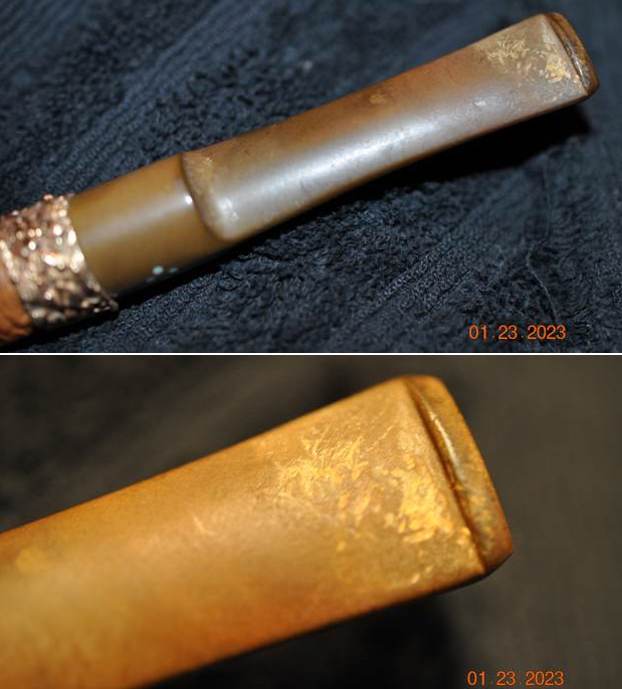
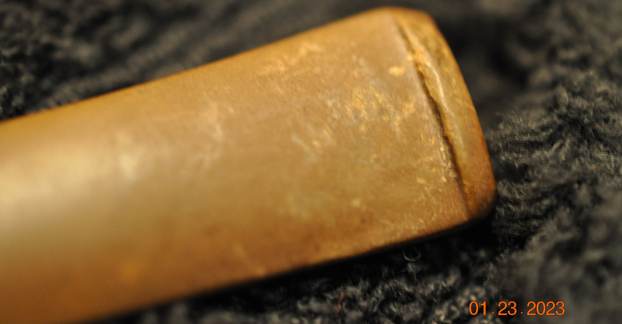 Instead of telling you what I see in the next photos of the sides of the bowl and the heel I want to hear from you. Tell me what you see? What does the finish look like to you? Are there any visible problems or issues that stand out to you? Are the cracks or scratches in sandblast finish of the bowl? Are there visible flaws or fissures in the briar? Note the fills that you see in the heel of the bowl. What does the finish look like? Is there a pattern to it? Any visible issues on the heel of the bowl? These questions should help you to see what I am looking for when I see these photos.
Instead of telling you what I see in the next photos of the sides of the bowl and the heel I want to hear from you. Tell me what you see? What does the finish look like to you? Are there any visible problems or issues that stand out to you? Are the cracks or scratches in sandblast finish of the bowl? Are there visible flaws or fissures in the briar? Note the fills that you see in the heel of the bowl. What does the finish look like? Is there a pattern to it? Any visible issues on the heel of the bowl? These questions should help you to see what I am looking for when I see these photos. 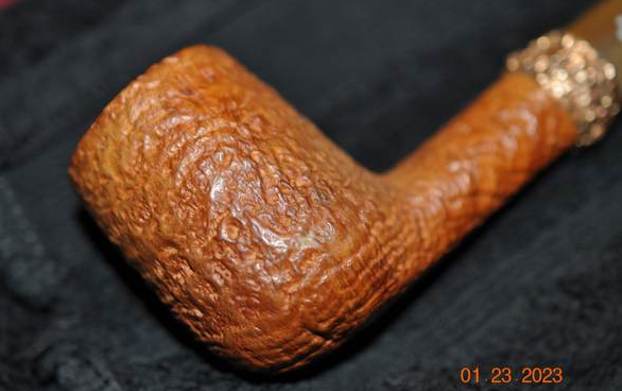
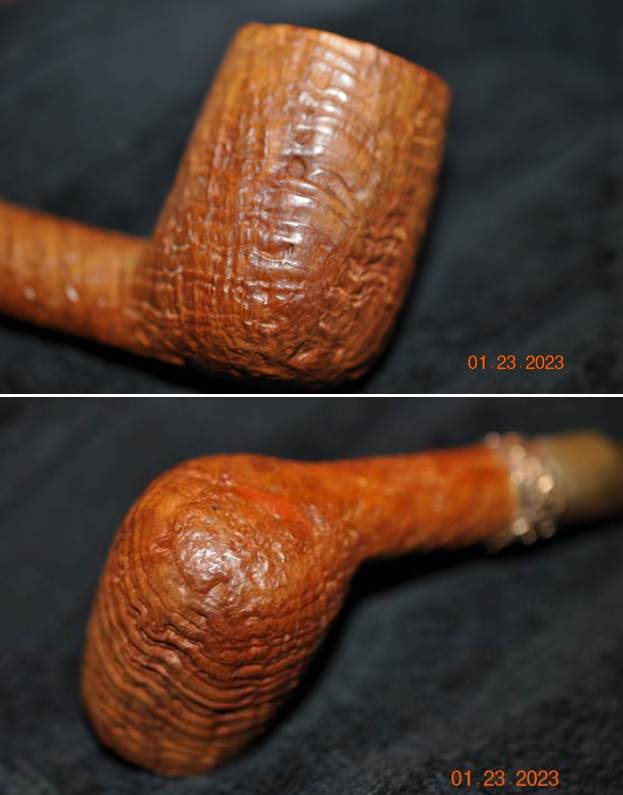 He took photos of the stamping on the underside of the shank. It is stamped as noted above on the right and the left sides. The stem shows the Sasieni Four Dots in light blue on the left side of the saddle portion of the saddle. What stands out for you in the photos of the stamping? What do you look for in the stamping? It is dirty but what do you see underneath the grime on the surface of the briar?
He took photos of the stamping on the underside of the shank. It is stamped as noted above on the right and the left sides. The stem shows the Sasieni Four Dots in light blue on the left side of the saddle portion of the saddle. What stands out for you in the photos of the stamping? What do you look for in the stamping? It is dirty but what do you see underneath the grime on the surface of the briar? 
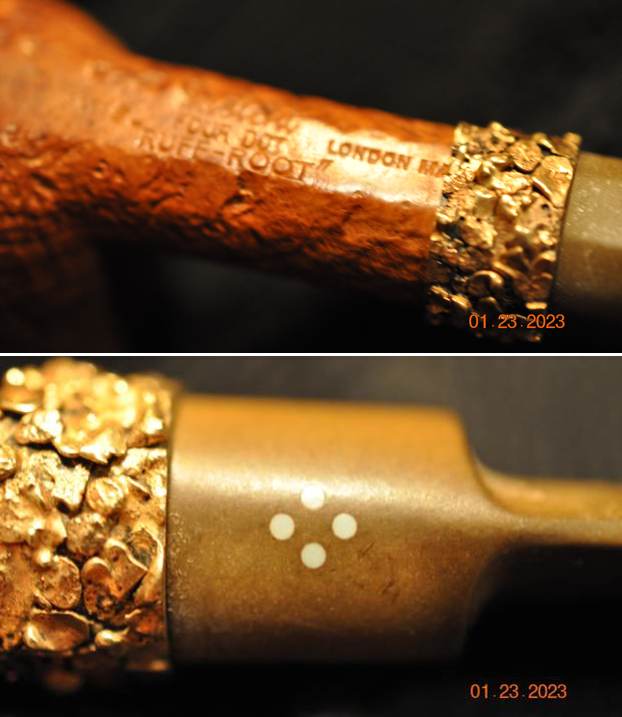 I decided to do some work on the stamping of this pipe to get an idea of the time period it was carved. I turned first to Pipephil’s site to see what I could learn (http://pipephil.eu/logos/en/logo-sasieni.html). I found a pipe that was stamped the same way as the one I am working on. It is stamped on the underside of the shank like the one in the screen capture photo below. Mine is stamped the same way Sasieni in script without the fish tail. Underneath it is stamped FOUR DOT NATURAL [over] London Made. Next to the shank is also the Made In England Stamp like the one below. On the heel of the bowl mine is stamped “Buckingham” S stamp rather than the “Appledore” stamp in the same place. I included the side bar notes below the picture. From that I knew that the pipe was made during Pre-transition Period 1946-1979.
I decided to do some work on the stamping of this pipe to get an idea of the time period it was carved. I turned first to Pipephil’s site to see what I could learn (http://pipephil.eu/logos/en/logo-sasieni.html). I found a pipe that was stamped the same way as the one I am working on. It is stamped on the underside of the shank like the one in the screen capture photo below. Mine is stamped the same way Sasieni in script without the fish tail. Underneath it is stamped FOUR DOT NATURAL [over] London Made. Next to the shank is also the Made In England Stamp like the one below. On the heel of the bowl mine is stamped “Buckingham” S stamp rather than the “Appledore” stamp in the same place. I included the side bar notes below the picture. From that I knew that the pipe was made during Pre-transition Period 1946-1979. Pre-transition, 1946 – 1979. Four dot. Ruff Root is the name for a sandblast finish. “Buckingham” is the shape name (town) that is used on the pipe I have in hand.
Pre-transition, 1946 – 1979. Four dot. Ruff Root is the name for a sandblast finish. “Buckingham” is the shape name (town) that is used on the pipe I have in hand.
I then turned to Pipedia for more detailed information (https://pipedia.org/wiki/Sasieni). I quote a section of that article below. It refers to the Patent Number that is on the pipe I have on the table. The underlined portion below is particularly pertinent to this pipe.
To begin with, there are three main elements to dating the Sasieni pipe, the patent number, the style of the name “Sasieni” as it appears on the shank, and the Dots themselves. Naturally, there are exceptions to these rules (this hobby would be boring without them), but for the most part these guidelines apply better than 95% of the time. All Sasieni One, Four, and Eight Dot pipes made before W.W.II and destined for the U. S. market carried a patent number on the shank which usually started with the numbers “15″, with 150221/20 and 1513428 being representative of the group. Also, the name “Sasieni” was stamped on the shank in a very florid manner, with the tail of the last “i” sweeping underneath the name forming a shape which has been compared to a fish by more than one collector. This script was discontinued by Alfred almost immediately after he took over the company, so this alone tells you your pipe is pre W.W.II. Underneath in block lettering are the words “London Made”, with the patent number making the third line.
The dots will help you narrow this down further. As we mentioned, the short lived U. S. market One Dot was introduced around 1920, and was replaced by the early to mid 1920’s by the Four Dot. The 1920’s Four Dot is distinguishable by the florid Sasieni script, a patent number, and four blue dots, which are quite small compared to the pipes of post war years. Furthermore, by 1935 Sasieni began stamping pipes, based on the shape, with their own names, which were usually, but not always, English towns. For example, apples were stamped “Hurlingham”, bulldogs were “Grosvenor” or “Danzey”, and panels were “Lincoln”. One rare and interesting variation of this was the large bent, dubbed “Viscount Lascelles”. Even in this soft Sasieni market, these pipes regularly sell for $150 in their rare appearances in mailers.
The pipe I have is one does not have a patent number so it was not made for the US market. The flourished “i” was discontinued by Alfred so that confirms that the pipe was made Pre-transition, 1946 –1979. The third line stamped is London Made in block lettering. With all that information I knew that my pipe was from the period before the transition (Pre Transition) so it was an older one.
I am sure many of you will shake your head and ask maybe even out loud, “Why is he including this again?” However, please remember that the point of these blogs is not to wow your with the work or make you shake your heads but I want you to know the details of the work we do so you can do your own. Back in 2020 Jeff wrote a blog about his cleaning process. I am including a link to that now so you can see what I mean about his process. Do not skip it! Give it a read (https://rebornpipes.com/2020/01/20/got-a-filthy-estate-pipe-that-you-need-to-clean/). Here is the introduction to that blog and it is very true even to this day.
Several have asked about Jeff’s cleaning regimen as I generally summarize it in the blogs that I post rather than give a detailed procedure. I have had the question asked enough that I asked Jeff to put together this blog so that you can get a clear picture of the process he uses. Like everything else in our hobby, people have different methods they swear by. Some may question the method and that is fine. But it works very well for us and has for many years. Some of his steps may surprise you but I know that when I get the pipes from him for my part of the restoration they are impeccably clean and sanitized. I have come to appreciate the thoroughness of the process he has developed because I really like working on clean pipe!
For the benefit of some of you who may be unfamiliar with some of the products he uses I have included photos of three of the items that Jeff mentions in his list. This will make it easier for recognition. These three are definitely North American Products so you will need to find suitable replacements or order these directly on Amazon. The makeup pads are fairly universal as we were able to pick some up in India when we were with Paresh and his family.
In the blog itself he breaks his process down into two parts – cleaning the stem and cleaning the bowl. Each one has a large number of steps that he methodically does every time. I know because I have watched him do the work and I have seen the pipes after his work on them. He followed this process step by step and when the pipe got to me it was spotlessly clean and ready for my work. The inside of the stem, shank and bowl were clean and to me that is an amazing gift as it means that my work on this end is with a clean pipe! I cannot tell you how much difference that makes for my work.
When the pipe arrives here in Vancouver I have a clean pipe and I go over it keeping in mind my assessment shared in the opening paragraph above. Now that I have it in hand I am looking for confirmation of what I saw in the photos as well as any significant structural changes in the bowl and finish as I go over it.
- The finish is clean and the oils have been removed from both sides of the bowl. The grime ground into the finish is gone and there is some great grain showing through the sandblast finish around the bowl sides.
- The lava coat and darkening on the rim top has been removed and it is very clean. The inner edge also looks very good.
- The cake had been totally removed and the walls of the bowl are clean. There is not any checking or burn damage on the interior walls of the bowl.
- The vulcanite saddle stem is clean and has light tooth chatter and marks on both sides. There is also some oxidation remaining on the stem surface.
- The four blue dots (Sasieni logo) on the left side of the saddle look very good.
Hopefully the steps above show you both what I look for when I go over the pipe when I bring it to the work table and also what I see when I look at the pipe in my hands. They also clearly spell out a restoration plan in short form. My work is clear and addressing it will be the next steps. I took photos of the whole pipe to give you a picture of what I see when I have it on the table. This is important to me in that it also shows that there was no damage done during the clean up work or the transit of the pipe from Idaho to here in Vancouver. 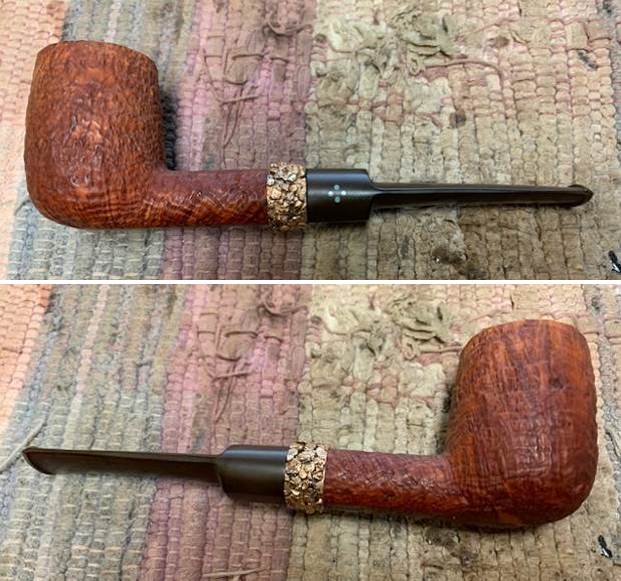
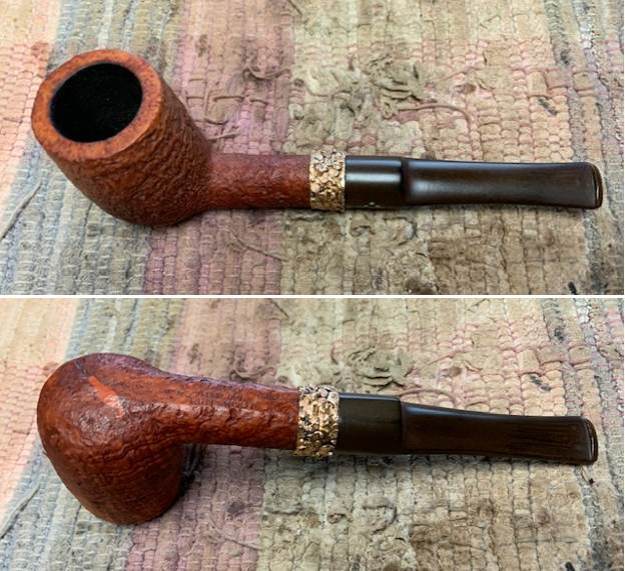 I carefully went over the bowl and rim top to get a sense of what is happening there. In this case once the lava was removed and the top looked good. There was some darkening around the inner edge, heavier toward the front of the bowl. It is clean but will need to be worked on to bring it back to normal. I also go over the stem carefully. There were some light tooth marks and dents on both sides of the stem. I took photos of the rim top and stem sides to show as best as I can what I see when I look at them.
I carefully went over the bowl and rim top to get a sense of what is happening there. In this case once the lava was removed and the top looked good. There was some darkening around the inner edge, heavier toward the front of the bowl. It is clean but will need to be worked on to bring it back to normal. I also go over the stem carefully. There were some light tooth marks and dents on both sides of the stem. I took photos of the rim top and stem sides to show as best as I can what I see when I look at them. I always check to make sure that the clean up work did not damage the stamping on the shank in any way. It looks good but is faint in some parts – particularly on the heel of the bowl. The putty fill is visible in the photo below. I always appreciate the handiwork of the carvers at Sasieni who turn a piece raw briar into a beautiful pipe. I love just looking at the beauty of the lay of the pipe with the grain and the proportion of the pipes. I like to remove the stem from the shank to get a sense of what was in the mind of the pipe maker when he crafted the pipe. It is a beauty in flow and shape.
I always check to make sure that the clean up work did not damage the stamping on the shank in any way. It looks good but is faint in some parts – particularly on the heel of the bowl. The putty fill is visible in the photo below. I always appreciate the handiwork of the carvers at Sasieni who turn a piece raw briar into a beautiful pipe. I love just looking at the beauty of the lay of the pipe with the grain and the proportion of the pipes. I like to remove the stem from the shank to get a sense of what was in the mind of the pipe maker when he crafted the pipe. It is a beauty in flow and shape.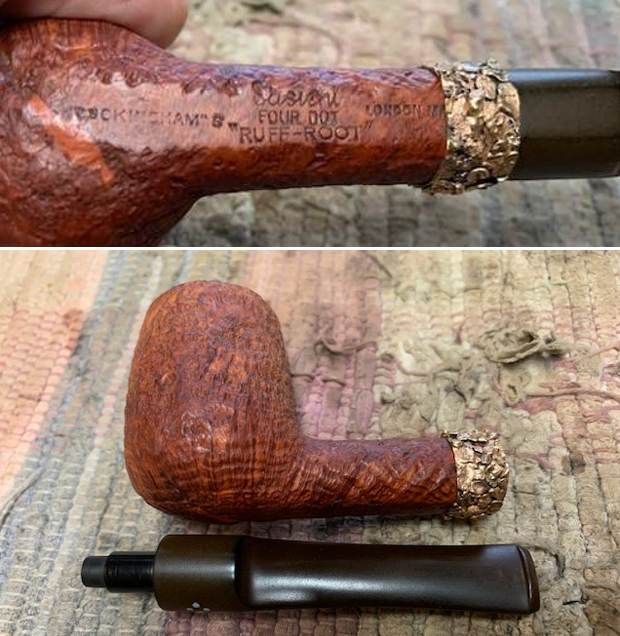 I started working on this pipe by turning to the bowl. I chose to deal with the darkening on the inner edge of the rim. I used a piece of 220 grit sandpaper to remove the darkening on the inner edge. It took a little work but I was able to remove most of the damage. It looks much better after I worked it over.
I started working on this pipe by turning to the bowl. I chose to deal with the darkening on the inner edge of the rim. I used a piece of 220 grit sandpaper to remove the darkening on the inner edge. It took a little work but I was able to remove most of the damage. It looks much better after I worked it over.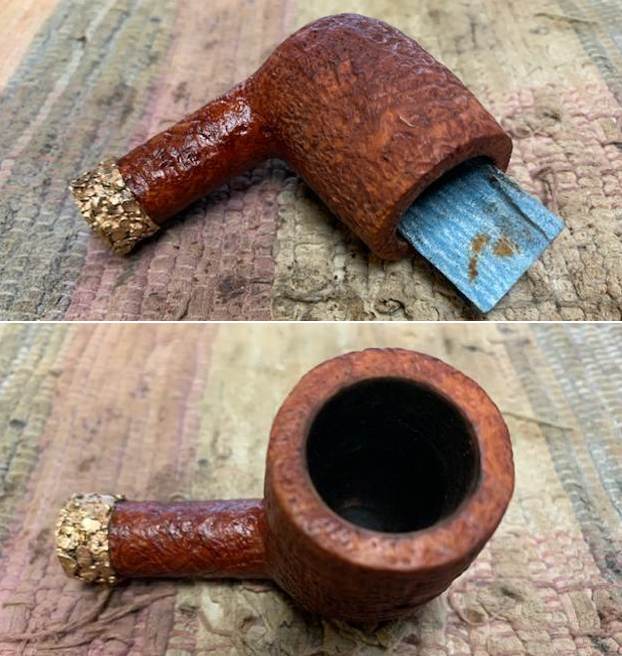 I used a Cherry Stain Pen to stain the putty fill and blend it into the surface of the sandblast billiard. It looked much better once it had cured.
I used a Cherry Stain Pen to stain the putty fill and blend it into the surface of the sandblast billiard. It looked much better once it had cured.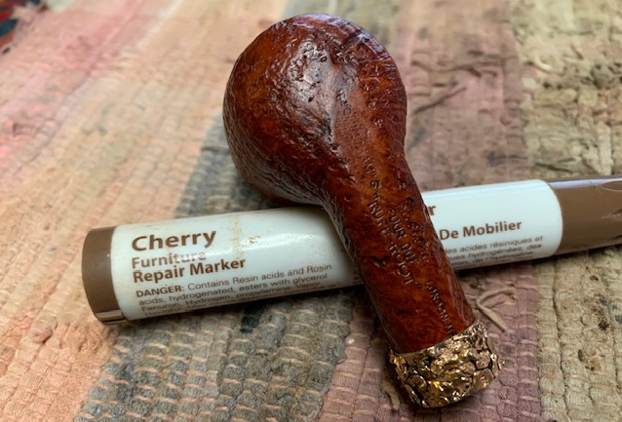 For the past few years now I have been using a product developed by Mark Hoover called Before & After Restoration Balm. It is a paste/balm that is rubbed into the surface of the briar. The product works to deep clean the finish, enliven and protect the briar. I worked it into the briar with my finger tips and a shoe brush and let it sit for 10 minutes to do its work. I wiped it off with a soft cloth then buffed it with a cotton cloth. The briar really began to shine and the grain shone through the blast. The photos I took of the bowl at this point mark the progress in the restoration. It is a gorgeous pipe.
For the past few years now I have been using a product developed by Mark Hoover called Before & After Restoration Balm. It is a paste/balm that is rubbed into the surface of the briar. The product works to deep clean the finish, enliven and protect the briar. I worked it into the briar with my finger tips and a shoe brush and let it sit for 10 minutes to do its work. I wiped it off with a soft cloth then buffed it with a cotton cloth. The briar really began to shine and the grain shone through the blast. The photos I took of the bowl at this point mark the progress in the restoration. It is a gorgeous pipe.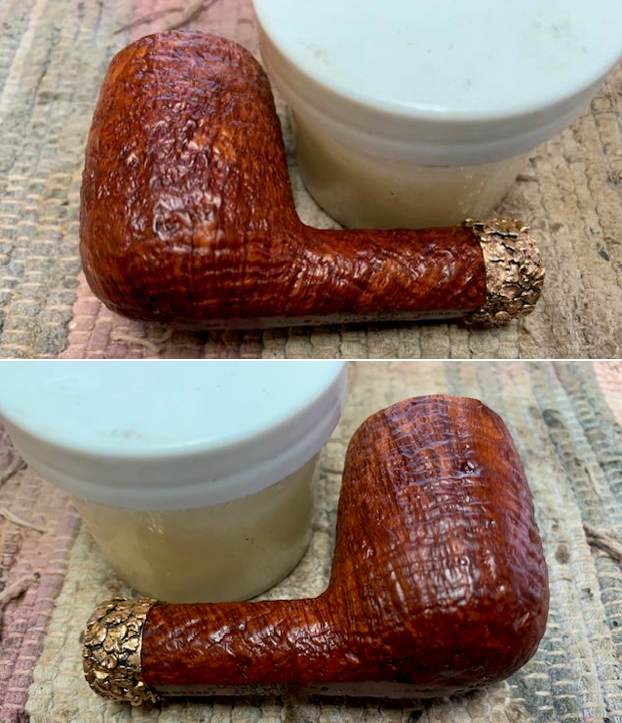
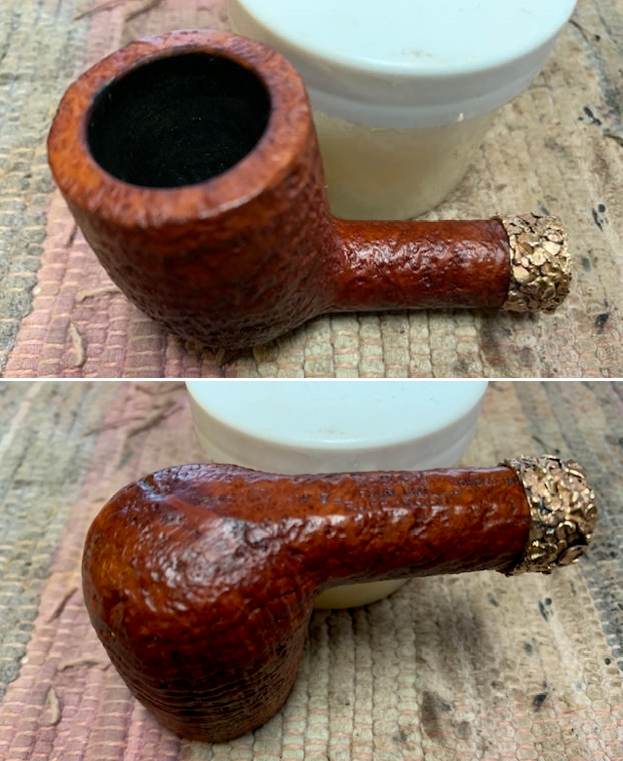
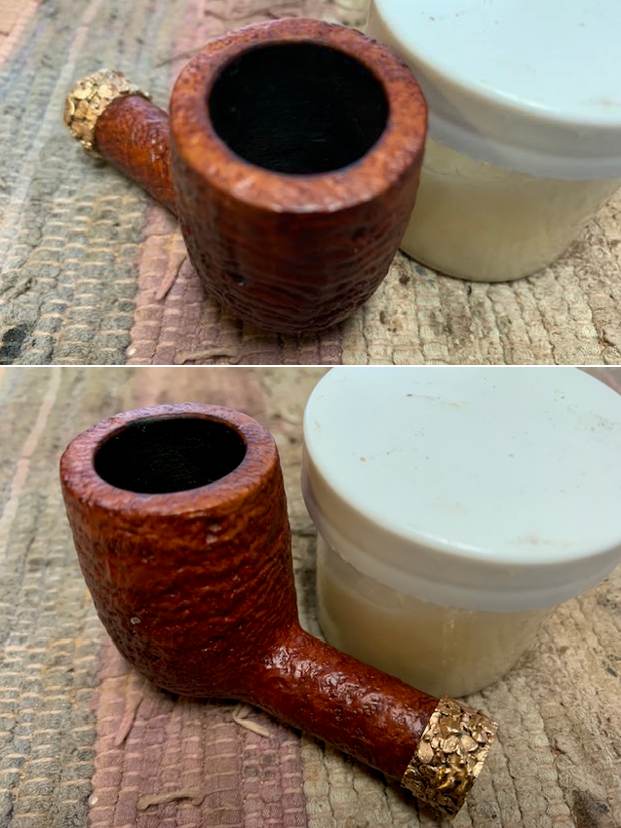 I set the bowl aside and turned to the stem. I “painted” the stem surface with the flame of a Bic lighter to lift the tooth marks. I was able to lift them and sanded out what remained with 220 grit sandpaper. I started the polishing of the stem with 600 grit wet dry sandpaper.
I set the bowl aside and turned to the stem. I “painted” the stem surface with the flame of a Bic lighter to lift the tooth marks. I was able to lift them and sanded out what remained with 220 grit sandpaper. I started the polishing of the stem with 600 grit wet dry sandpaper.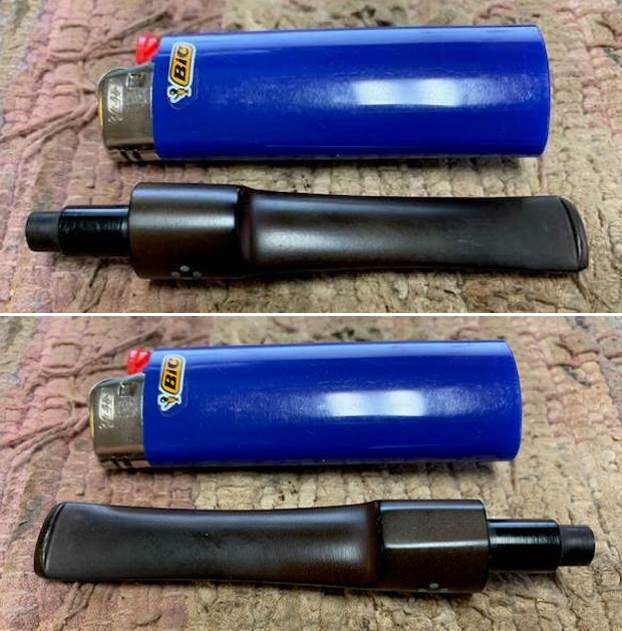
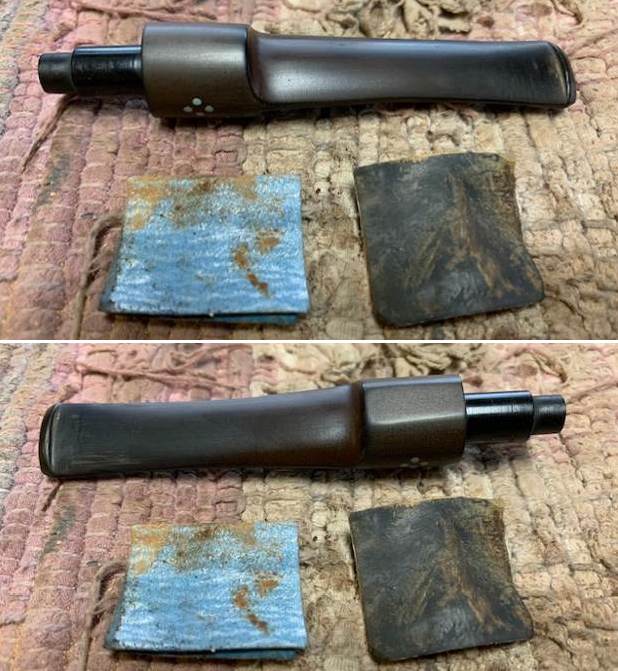 I wiped the stem down with Soft Scrub cleanser to remove the remaining oxidation on the stem surface. It looked much better.
I wiped the stem down with Soft Scrub cleanser to remove the remaining oxidation on the stem surface. It looked much better. 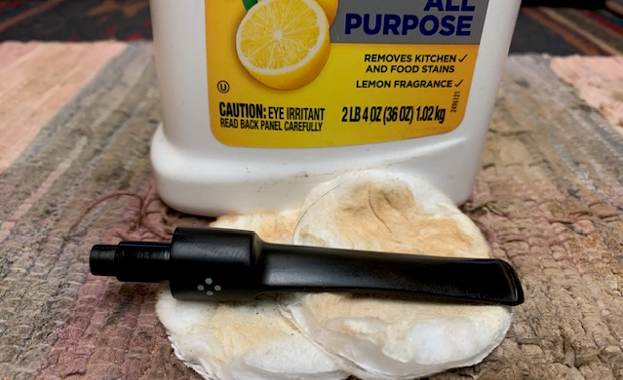 I polished the stem with micromesh sanding pads – 1500-12000 grit sanding pads and water to wet sand the stem. I wiped it down after each sanding pad with Obsidian Oil on a cotton rag after each sanding pads. I know that many say Obsidian Oil does nothing for acrylic stems, but I find it does two things – first it gives some protection to the stem from buildup and second it give the sanding pads bite in the polishing process.
I polished the stem with micromesh sanding pads – 1500-12000 grit sanding pads and water to wet sand the stem. I wiped it down after each sanding pad with Obsidian Oil on a cotton rag after each sanding pads. I know that many say Obsidian Oil does nothing for acrylic stems, but I find it does two things – first it gives some protection to the stem from buildup and second it give the sanding pads bite in the polishing process. 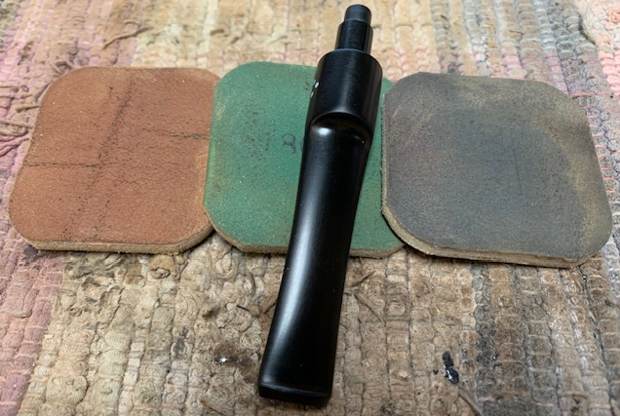
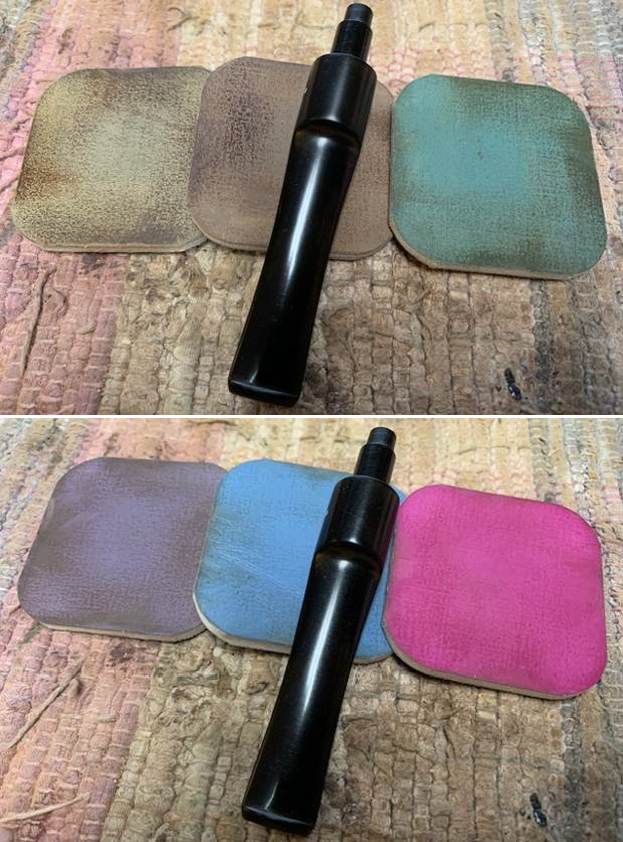 After finishing with the micromesh pads I rub the stem down with Before & After Fine and Extra Fine stem polish as it seems to really remove the fine scratches in the acrylic. I rub the Fine Polish on the stem and wipe it off with a paper towel and then repeat the process with the Extra Fine polish. I finish the polishing of the stem down with a final coat of Obsidian Oil and set the stem aside to let the oil absorb. This process gives the stem a shine and also a bit of protection.
After finishing with the micromesh pads I rub the stem down with Before & After Fine and Extra Fine stem polish as it seems to really remove the fine scratches in the acrylic. I rub the Fine Polish on the stem and wipe it off with a paper towel and then repeat the process with the Extra Fine polish. I finish the polishing of the stem down with a final coat of Obsidian Oil and set the stem aside to let the oil absorb. This process gives the stem a shine and also a bit of protection. The final steps in my process involve using the buffer. I don’t buff a sandblast finish on the buffer with polish as it can fill in the deep grooves. I buffed the stem with Blue Diamond to polish out the light scratches in the vulcanite. I gave the bowl multiple coats of Conservators Wax and the stem multiple coats of carnauba wax. I have found that I can get a deeper shine if I follow up the wax buff with a buff with a clean buffing pad. It works to raise the shine and then I hand buff with a microfiber cloth to deepen the shine. It is always fun for me to see what the polished bowl looks like with the polished stem. It really is a nice pipe. The smooth finish around the bowl sides and shank looks great with rusticated plateau style crowned rim. The acrylic stem works well with the pipe. The Sasienin Four Dot Ruff Root Sandblast Billiard with a craggy gold shank adornment feels great in my hand. It is a well balanced pipe. Have a look at it with the photos below. The dimensions are Length: 6 inches, Height: 1 ¾ inches, Outside diameter of the bowl: 1 ¼ inches, Chamber diameter: 7/8 of an inch. The weight of the pipe is 1.62 ounces/46 grams. It is a beautiful pipe that I will soon be adding to the rebornpipes store in the British Pipemakers Section. If you would like to add it to your collection let me know. It should be a great smoking pipe.
The final steps in my process involve using the buffer. I don’t buff a sandblast finish on the buffer with polish as it can fill in the deep grooves. I buffed the stem with Blue Diamond to polish out the light scratches in the vulcanite. I gave the bowl multiple coats of Conservators Wax and the stem multiple coats of carnauba wax. I have found that I can get a deeper shine if I follow up the wax buff with a buff with a clean buffing pad. It works to raise the shine and then I hand buff with a microfiber cloth to deepen the shine. It is always fun for me to see what the polished bowl looks like with the polished stem. It really is a nice pipe. The smooth finish around the bowl sides and shank looks great with rusticated plateau style crowned rim. The acrylic stem works well with the pipe. The Sasienin Four Dot Ruff Root Sandblast Billiard with a craggy gold shank adornment feels great in my hand. It is a well balanced pipe. Have a look at it with the photos below. The dimensions are Length: 6 inches, Height: 1 ¾ inches, Outside diameter of the bowl: 1 ¼ inches, Chamber diameter: 7/8 of an inch. The weight of the pipe is 1.62 ounces/46 grams. It is a beautiful pipe that I will soon be adding to the rebornpipes store in the British Pipemakers Section. If you would like to add it to your collection let me know. It should be a great smoking pipe.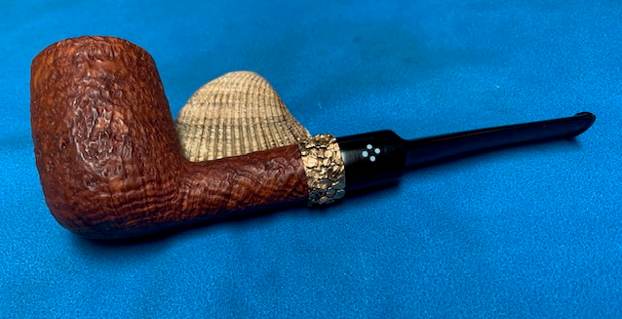
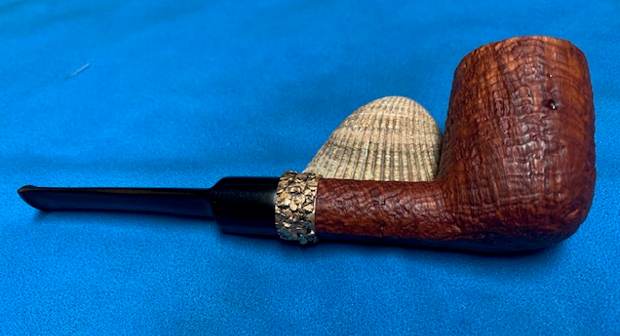
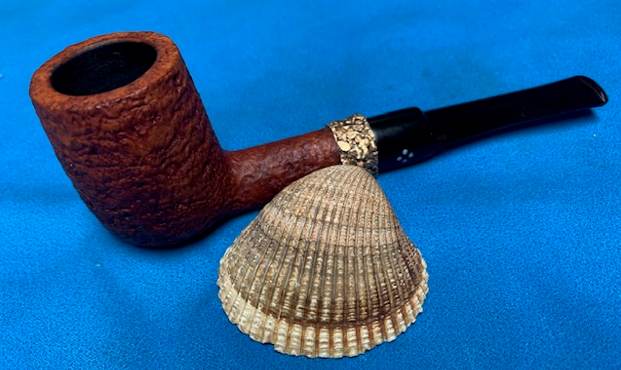

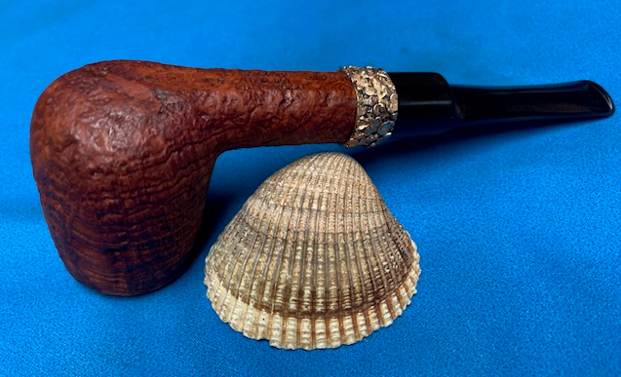
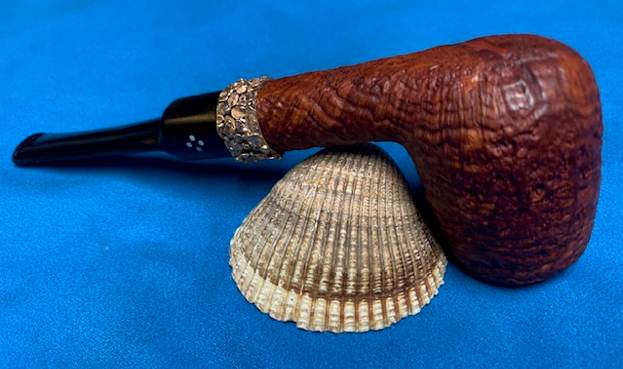
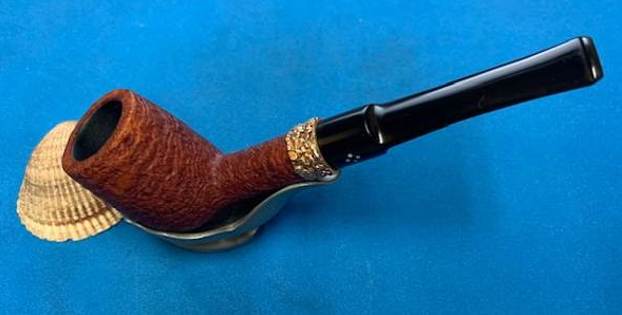
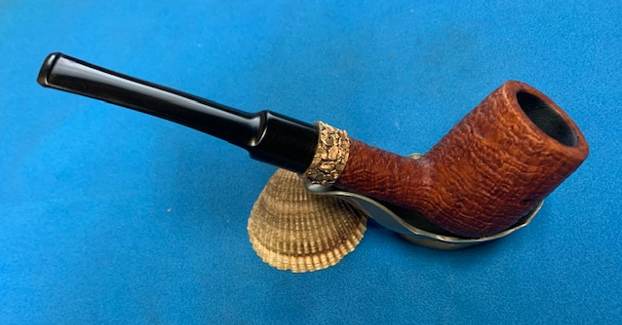
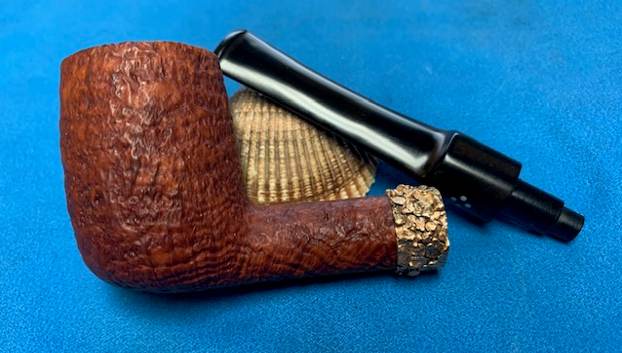
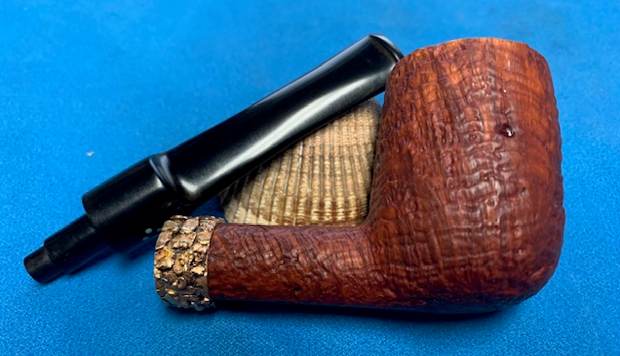
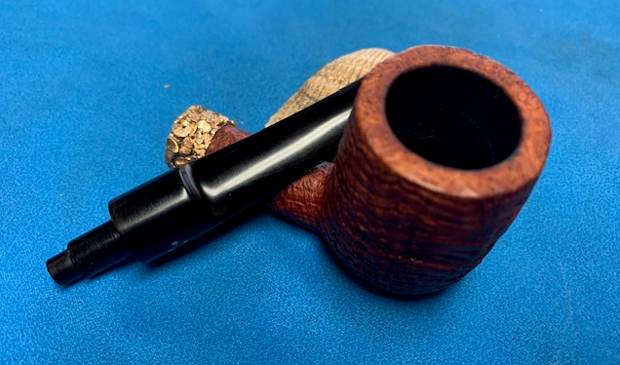
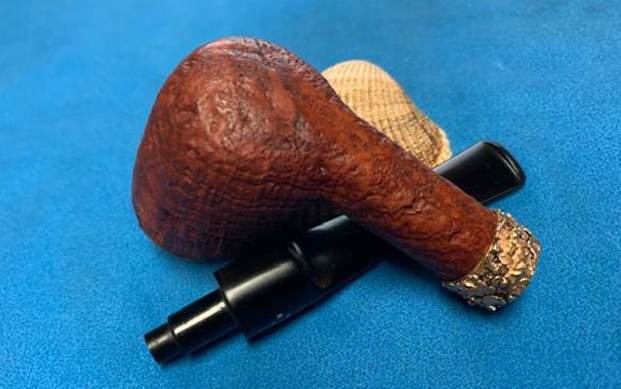
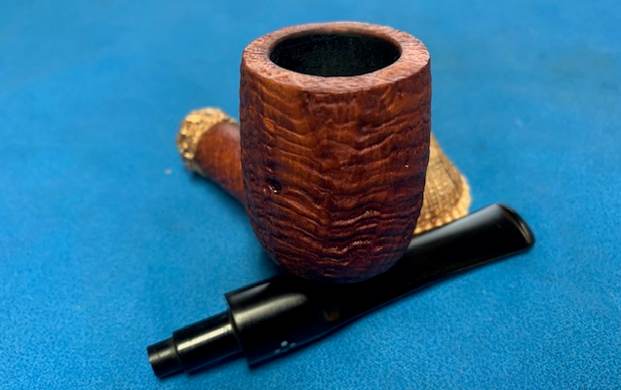
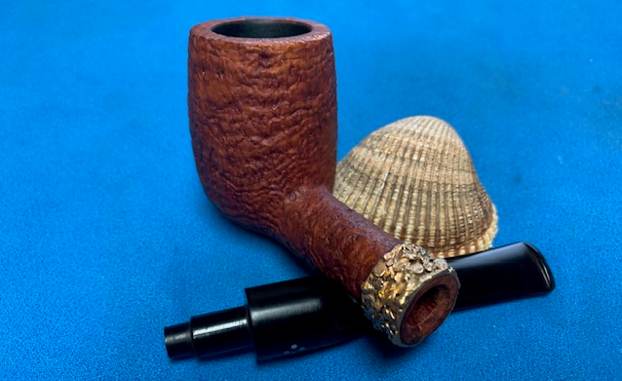
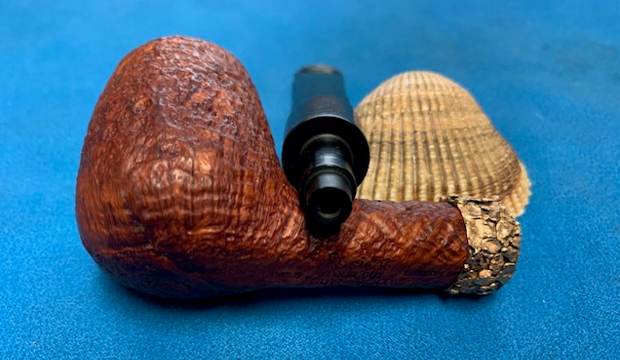
 Hopefully the style of writing of this blog is helpful to you in some way. In it I wanted to show both what I am looking for and how I move forward in addressing what I see when work on a pipe. Let me know if it is helpful to you. It is probably the most straightforward detailed description of my work process that I have done. As always I encourage your questions and comments as you read the blog. Thanks to each of you who are reading this blog. Remember we are not pipe owners; we are pipe men and women who hold our pipes in trust until they pass on into the trust of those who follow us.
Hopefully the style of writing of this blog is helpful to you in some way. In it I wanted to show both what I am looking for and how I move forward in addressing what I see when work on a pipe. Let me know if it is helpful to you. It is probably the most straightforward detailed description of my work process that I have done. As always I encourage your questions and comments as you read the blog. Thanks to each of you who are reading this blog. Remember we are not pipe owners; we are pipe men and women who hold our pipes in trust until they pass on into the trust of those who follow us.

